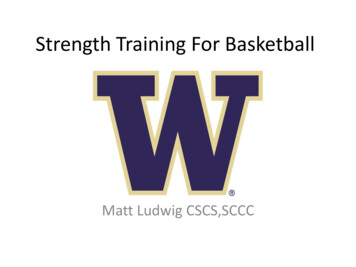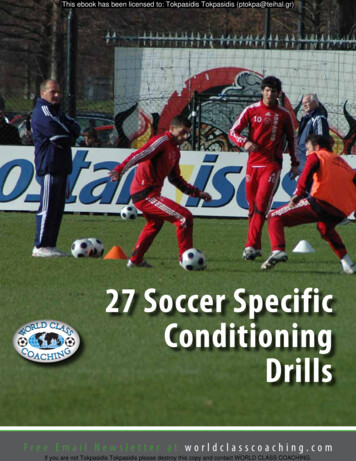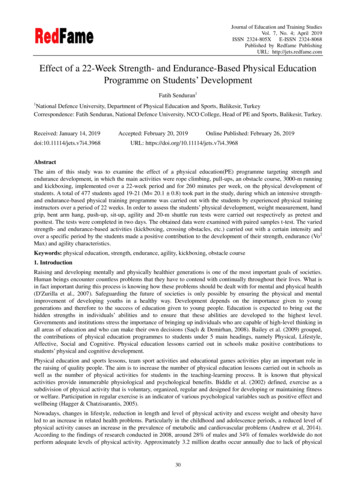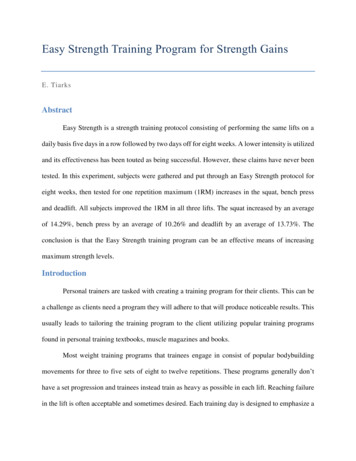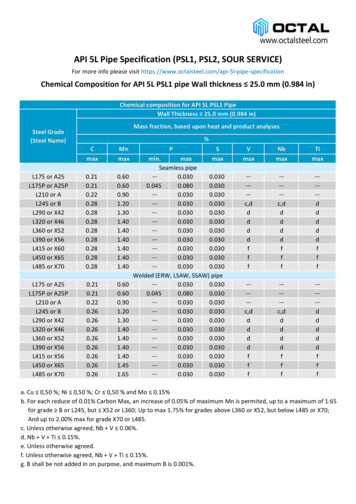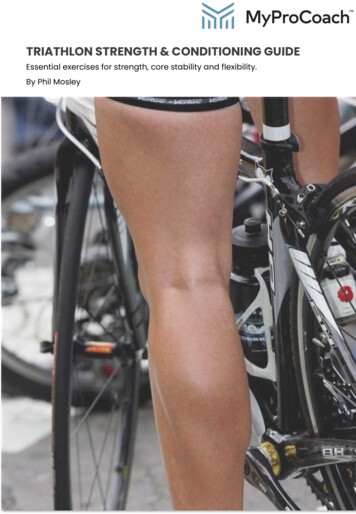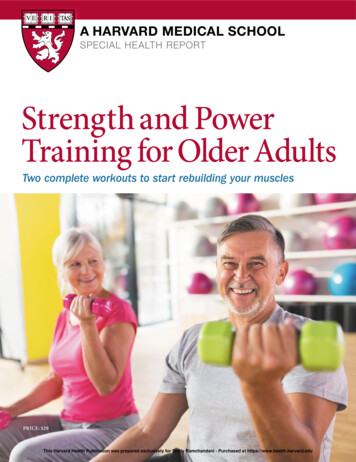
Transcription
A HARVARD MEDICAL SCHOOLSPECIAL HEALTH REPORTStrength and PowerTraining for Older AdultsTwo complete workouts to start rebuilding your musclesPRICE: 29This Harvard Health Publication was prepared exclusively for Shirly Ramchandani - Purchased at https://www.health.harvard.edu
Copyright NoticeTHIS REPORT IS COPYRIGHTED BY HARVARD UNIVERSITY AND IS PROTECTED BYU.S. AND INTERNATIONAL COPYRIGHT. ALL RIGHTS RESERVED.Here’s what you CAN do Print out one copy and route this “original” tofamily. You are permitted to have one copy of thispublication on your computer at any time (youcan’t put it on a network unless you purchaseda license to do so). If you have paid for morecopies, then you may have that many copies oncomputers at any time. Copy, on an occasional basis, a couple of pagesto give to friends, family members, or colleagues. We are registered with the Copyright ClearanceCenter (CCC). You can comply with the copyrightlaws by paying a royalty on copies you make ofpassages. But not even the CCC can authorizecover-to-cover photocopying or wholesaleelectronic forwarding. If you want to distribute copies of thispublication, either in print or electronic form,to others on a regular basis, ask us about bulkdiscounts or licensing opportunities. You maybe able to negotiate an agreement, for a singlefee, that would enable you to legally distributephotocopies or electronic copies to others.Here’s what you CAN’T do(without prior permission) Make or forward email copies of an entirepublication. The law provides for a verylimited amount of copying, commonly referredto as “fair use.” However, cover-to-coverphotocopying is forbidden. Electronic transmission of a copyrightedwork is the legal equivalent of photocopyingit (and so is posting it on the Internet or inan electronic database), and is therefore notallowed. Routinely copy and distribute portions. Republish or repackage the contents.Some publishers must resort to lawsuits toprotect their publications. Harvard HealthPublications would like to eliminate the need forsuch suits by helping to educate customers.We hope this outline has helped explain what islegal and what is not.For more informationPermissions RequestsHarvard Health Publicationswww.health.harvard.edu/permissionsFor Licensing, Bulk Rates, orCorporate SalesHHP licensing@hms.harvard.edu, orvisit us at www.content.health.harvard.eduHarvard Health PublicationsHarvard Institutes of Medicine, 4th Floor4 Blackfan CircleBoston, MA 02115www.health.harvard.eduHarvard Health Publications Harvard Institutes of Medicine Fourth Floor, 4 Blackfan Circle Boston, MA 02115This Harvard Health Publication was prepared exclusively for Shirly Ramchandani - Purchased at https://www.health.harvard.edu
STRENGTH AND POWER TRAININGFOR OLDER ADULTSSPECIAL HEALTH REPORTMedical EditorElizabeth Pegg Frates, MDClinical Assistant Professor,Harvard Medical SchoolFitness ConsultantMichele StantenCertified Fitness Instructor,American Council on ExerciseExecutive EditorAnne UnderwoodCopy EditorRobin NethertonCreative DirectorJudi CrouseProduction ManagerLori WendinIllustratorsBarb Cousins, Matthew Holt, Scott LeightonPublished by Harvard Medical SchoolGregory D. Curfman, MD, Editor in ChiefUrmila R. Parlikar, Senior Content EditorIn association withBelvoir Media Group, LLC, 535 Connecticut Avenue, Norwalk, CT 06854-1713. Robert Englander, Chairman andCEO; Timothy H. Cole, Executive Vice President, EditorialDirector; Philip L. Penny, Chief Operating Officer; GregKing, Executive Vice President, Marketing Director; Ron Goldberg,Chief Financial Officer; Tom Canfield, Vice President, Circulation.Copyright 2015 by Harvard University. Permission isrequired to reproduce, in any manner, in whole, or in part,the material contained herein. Submit reprint requests to:Harvard Health Publications Permissions10 Shattuck St., 2nd Floor, Boston, MA 02115www.health.harvard.edu/permissionsPhone: 617-432-2876 Fax: 617-432-1506WebsiteFor the latest information and most up-to-date publicationlist, visit us online at www.health.harvard.edu.Customer ServiceFor all subscription questions or problems (rates,subscribing, address changes, billing problems), emailto HarvardProd@StrategicFul fillment.com, call 877649-9457 (toll-free), or write to Harvard HealthPublications, P.O. Box 9308, Big Sandy, TX 75755-9308.Ordering Special Health ReportsHarvard Medical School publishes Special Health Reportson a wide range of topics. To order copies of this or otherreports, please see the instructions at the back of thisreport, or go to our website: www.health.harvard.edu.For Licensing, Bulk Rates, or Corporate Sales:Call 203-828-0349, oremail HHP licensing@hms.harvard.edu,or visit www.harvardhealthcontent.comContentsThe basics: Strength training, power training,and your muscles . . . . . . . . . . . . . . . . . . . . . . . . . . . . . . . . . 2Strength training: The traditional approach. . . . . . . . . . . . . . . . . . 2Power training: A complementary approach . . . . . . . . . . . . . . . . . 2A look at muscles and movement . . . . . . . . . . . . . . . . . . . . . . . . 3What strength and power training can do for you. . . . . . . . . 7Health benefits of power training. . . . . . . . . . . . . . . . . . . . . . . . . 7Health benefits of strength training . . . . . . . . . . . . . . . . . . . . . . . 8Easing arthritis pain. . . . . . . . . . . . . . . . . . . . . . . . . . . . . . . . . . 8Reducing heart disease risk . . . . . . . . . . . . . . . . . . . . . . . . . . . 10Slowing osteoporosis. . . . . . . . . . . . . . . . . . . . . . . . . . . . . . . . 12Improving diabetes. . . . . . . . . . . . . . . . . . . . . . . . . . . . . . . . . . 13Other conditions. . . . . . . . . . . . . . . . . . . . . . . . . . . . . . . . . . . . 14Getting set up. . . . . . . . . . . . . . . . . . . . . . . . . . . . . . . . . . . 16Buying basic equipment . . . . . . . . . . . . . . . . . . . . . . . . . . . . . . 16Investing wisely in large equipment . . . . . . . . . . . . . . . . . . . . . . 16Personal trainers, physical therapists, and physiatrists. . . . . . . . 17Safety first. . . . . . . . . . . . . . . . . . . . . . . . . . . . . . . . . . . . . . 20Questions for your doctor . . . . . . . . . . . . . . . . . . . . . . . . . . . . . 20Tips for avoiding injury . . . . . . . . . . . . . . . . . . . . . . . . . . . . . . . 21Designing your program . . . . . . . . . . . . . . . . . . . . . . . . . . . 23Frequently asked questions. . . . . . . . . . . . . . . . . . . . . . . . . . . . 23Current exercise recommendations. . . . . . . . . . . . . . . . . . . . . . 25Your workout calendar . . . . . . . . . . . . . . . . . . . . . . . . . . . . . . . 26Workout I: A strong beginning. . . . . . . . . . . . . . . . . . . . . . . 28Performing the exercises . . . . . . . . . . . . . . . . . . . . . . . . . . . . . 29Workout II: Stepping it up a notch . . . . . . . . . . . . . . . . . . . 32Performing the exercises . . . . . . . . . . . . . . . . . . . . . . . . . . . . . 33Balancing and stretching exercises. . . . . . . . . . . . . . . . . . . 36Balancing . . . . . . . . . . . . . . . . . . . . . . . . . . . . . . . . . . . . . . . . 36Stretching . . . . . . . . . . . . . . . . . . . . . . . . . . . . . . . . . . . . . . . . 37SPECIAL SECTION: Strength training over a lifetime:Keys to staying motivated. . . . . . . . . . . . . . . . . . . . . . . . . . 40Resources. . . . . . . . . . . . . . . . . . . . . . . . . . . . . . . . . . . . . . 47Glossary. . . . . . . . . . . . . . . . . . . . . . . . . . . . . . . . . . . . . . . . 48ISBN 978-1-61401-114-9The goal of materials provided by Harvard Health Publicationsis to interpret medical information for the general reader.This report is not intended as a substitute for personal medicaladvice, which should be obtained directly from a physician.Cover Image: PIKSEL ThinkstockThis Harvard Health Publication was prepared exclusively for Shirly Ramchandani - Purchased at https://www.health.harvard.edu
Dear Reader,Slowly but surely the message is getting out: strength training isn’t just for bodybuilders withbulging biceps and rippling abdominal muscles. Like aerobic exercise, it’s important for everybody, and everyone should include it in his or her exercise program. Studies show that strengthtraining can help prevent or control conditions as varied as heart disease, diabetes, arthritis, andosteoporosis. And no matter what your age, it’s not too late. The time to start is now, if you wantto preserve your quality of life and fight off frailty.Strength training has many benefits in addition to those listed above. It can tone your musclesand make any sport you play more enjoyable. As you grow older, it can help you perform thetasks of everyday life, such as climbing a flight of stairs, carrying a bag of groceries, putting awaya heavy dish in a high cabinet, or even just getting out of a chair.Recently we’ve also begun learning about a related concept called power training, which buildsboth strength and speed. There is overlap between the two, but think of it this way: powertraining helps you move faster when you walk (allowing you to get across an intersection in asafe amount of time) or react faster (keeping a trip from becoming a fall). The concept of powertraining was developed in part by our colleagues Jonathan F. Bean and Walter R. Frontera. It wasDrs. Bean and Frontera who wrote the original version of this report, which we would like torecognize and acknowledge here.Muscles naturally weaken with age—starting in your 30s—so you need to keep working themin order to retain strength and power. The good news is that your investment in exercise canyield quick returns. Studies have found that just 10 weeks of weight workouts can dramaticallyimprove strength, power, mobility, and agility, even in men and women in their 70s, 80s, and 90s.If you’re like many older adults, you may be leery of working out with trainers who are decadesyounger than you and who don’t understand the limitations of aging bodies. In this report, youwill find two workouts geared to older adults that include both strength and power training.You’ll learn how to begin slowly and safely, and what equipment you need to get started. It isn’tmuch. For our easy-to-follow workouts, all you need are sneakers, comfortable exercise clothes,some dumbbells, ankle weights, and a sturdy chair. If you already use weights, you will learn howto step up the pace and keep your routines interesting and fun.Have fun working out. We do!Sincerely,Elizabeth Pegg Frates, M.D.Medical EditorMichele StantenFitness ConsultantHarvard Health Publications Harvard Medical School 10 Shattuck Street, Second Floor Boston, MA 02115This Harvard Health Publication was prepared exclusively for Shirly Ramchandani - Purchased at https://www.health.harvard.edu
The basics: Strength training, power training,and your musclesIt’s one thing to live a long life. It’s another to live longand well. The burgeoning field of lifestyle medicinehas a perfect description of this goal: “adding not onlyyears to your life, but life to your years.” But how doyou do that? When it comes to staying healthy andliving longer, many people think of eating a hearthealthy diet to reduce their risks of a heart attack orcontrolling blood pressure to help prevent strokes.These are indisputably excellent goals. But the truthis, maintaining your muscles should also be high onyour list.Your muscles enable you to carry groceries, hoistsuitcases into the car, climb stairs, get out of a chair,swing a golf club, and dance the tango. The strongerand more powerful your muscles are, the easier all ofthese everyday tasks and others will be. But neglectyour muscles, and it will certainly complicate your life.Weak muscles turn seemingly simple tasks like walking into a chore and are a primary reason that manypeople lose their independence as they age.Strength and power training can curb or evenhalt these changes, so your muscles function at a highlevel even as you get older. And there are additionalbenefits. As you strengthen your muscles, you toneyour arms and legs. You also burn more calories, sincemuscles require energy (calories) in order to function.You can even help control various medical problems.For example, you can reduce your risk of heart disease, slow the advance of osteoporosis, ease arthritispain, and help manage or prevent type 2 diabetes (see“What strength and power training can do for you,”page 7). It’s never too late to start. Studies of people intheir 70s, 80s, even 90s have shown that it’s possible torebuild muscle and strength at these ages.So exactly what is strength training? What ispower training? How do your muscles respond tothese exercises? You’ll find answers to these questionsin this chapter. You’ll also learn how muscles work and2Strength and Power Training for Older Adults how aging and disuse contribute to the loss of musclestrength and power over the years.Strength training: The traditionalapproachStrength training is a popular term for exercisesthat build muscle by harnessing resistance—that is,an opposing force that muscles must strain against.Strength training is sometimes called resistancetraining, progressive resistance training, or weighttraining. Resistance can be supplied by your bodyweight, free weights such as dumbbells and weightedcuffs, elasticized bands, or specialized machines. Nomatter what kind of resistance you use, putting morethan the usual amount of load on your muscles makesthem stronger. These exercises can strengthen yourbones as well because your muscles are attached tounderlying bones. When your muscles contract, theypull on the bones, and this force stimulates the bonesto get stronger.Strength training is not just for 20-somethings insearch of buff bodies or bulked-up muscles. While itcan certainly reshape a person’s silhouette in a pleasing way, it can also boost the strength everyone needsfor daily tasks. Just about any activity becomes easierwith stronger muscles. So will any sport you enjoy.Power training: A complementaryapproachAnother type of training, known as power training, isproving to be just as important as traditional strengthtraining in helping maintain or restore functional abilities—maybe even more important.As the name suggests, power training is aimedat increasing power, which is the product of bothstrength and speed, reflecting how quickly you canw w w.h ealt h .ha r va r d.e duThis Harvard Health Publication was prepared exclusively for Shirly Ramchandani - Purchased at https://www.health.harvard.edu
exert force to produce the desired movement. Thus,faced with a four-lane intersection, you may haveenough strength to walk across the street. But can youcross all four lanes of traffic before the light changes?Power, not just strength, can get you from one side tothe other safely. Likewise, by helping you react swiftlyif you trip or lose your balance, power can actuallyprevent falls.Some power moves are just strength training exercises done at a faster speed. Other power routines relyon the use of a weighted vest, which is worn while performing certain exercises that are typically aimed atimproving functions such as bending, reaching, lifting, and rising from a seated position. But you don’tneed a vest to do the power training moves we illustrate in our workouts.As you age, muscle power declines even moreswiftly than strength does—as much as 3.5% a year.So exercises that can produce gains in power becomeespecially important as you get older. That’s why somedoctors, physical therapists, and personal trainers arenow combining the swift moves of power trainingwith slower, more deliberate strength training exercises to reap the benefits of both activities.cle fibers, you will find glycogen (sugar) and fat storesthat provide energy for muscle contraction.In order for the fibers to function together asa unit, they are grouped together in small bundlesknown as fasciculi (see Figure 1, below); each bundleis sheathed in connective tissue known as the perimysium. A membrane called the epimysium surroundseach muscle and attaches the end of the muscle to atendon—a cord of connective tissue that tethers muscle to bone.Still, a muscle could not contract without nerveimpulses. A single nerve cell, or motor neuron, directsactivity in a specific group of muscle fibers. Together,this grouping of nerve cell and muscle fibers is called amotor unit. If a given nerve cell commands few muscle fibers, the motor unit marshals less force; the morefibers a nerve cell controls, the greater the force theunit exerts.Figure 1: An in-depth look at muscleTendonBoneMuscleA look at muscles and movementBefore you read about the health benefits of theseforms of exercise or try specific exercises, it helps tolearn a bit about how your muscles work.Strength training—or actually any voluntarymovement in the body—is made possible by skeletalmuscles, which are attached to bone. The body boastsmore than 600 skeletal muscles that enable you towalk, twist, swing your arms, turn your head, flex yourfeet, wiggle your toes, and more.A muscle seems like a simple thing. But a singlemuscle may have from 10,000 to over a million musclefibers (also known as muscle cells). A muscle fiber itselfis composed largely of hundreds to thousands of interlocked strands called myofibrils. Myofibrils in turn aredivided into a series of repeating segments called sarcomeres, which are considered the contracting unit ofskeletal muscle. Within sarcomeres are bands of contractile proteins, called myofilaments. Also inside musww w. h ealt h . h ar v ar d . e duMuscleEpimysiumMuscle fibersPerimysiumMyofibrilBundles of musclefibers (fasciculi)Your muscles are joined to bone by cords of tissue known as tendons and are covered in connective tissue known as the epimysium.If you could look inside your muscles, you would find that they arecomposed of small bundles of muscle fibers, known as fasciculi.These bundles are surrounded by connective tissue, known as theperimysium. One muscle may have anywhere from 10,000 to morethan a million muscle fibers. In turn, each muscle fiber consists ofhundreds to thousands of tiny, interlocking strands called myofibrils.Strength and Power Training for Older AdultsThis Harvard Health Publication was prepared exclusively for Shirly Ramchandani - Purchased at https://www.health.harvard.edu3
When nerve impulses originating in the brainshoot along neural pathways toward a muscle, theytrigger a complex set of chemical reactions thatcause myofilaments to slide over each other, generating force. Movement occurs when that force ripplesthrough the muscle structure to the tendons, which inturn tug on the bones. Essentially, the bunching muscles act like strings that make a puppet spring to life.Strength and power training exercises push musclebeyond its usual capacity. Muscles grow in responseto this stimulus because the exercises increase theproduction of new muscle protein. When this cycleoccurs repeatedly, muscles become stronger, muscle mass increases, and muscles may become visiblylarger, particularly in men. Women can develop moreshapely arms and legs, but they are unlikely to developbig, bulky muscles unless they spend hours a day inthe gym, because they don’t have enough testosterone for that. Interestingly, even if there is no musclegrowth, strength and power training enhance the ability of the nervous system to activate motor units.Slow-twitch and fast-twitch fibersMost skeletal muscles have two main types of musclefibers: slow-twitch and fast-twitch. Usually, a combination of these types gets pressed into service when youexercise. Slow-twitch fibers function best during lowintensity activities, when they can be supplied withoxygen. These fibers can keep acting for long periodsof time and are called upon first for most activities,including aerobic activities such as walking, swimming, biking, or jogging. During anaerobic activity(rapid, high-intensity exercise in which your body isunable to meet the muscles’ significantly higher oxygen demands—for example, short bouts of sprinting,jumping, or scrambling up a hill), fast-twitch fibersstep into the breach to create bursts of power. Fasttwitch fibers churn out more force than slow-twitchfibers, but are more quickly exhausted. Successful distance runners tend to have greater numbers of slowtwitch fibers in the muscles of their calves, while elitesprinters generally have more fast-twitch fibers. Generally speaking, classic strength training is better fordeveloping slow-twitch fibers, while power trainingfavors the fast-twitch fibers. But in fact, you usually4Strength and Power Training for Older Adults use both to varying degrees when you exercise.Studies show that functional activities—that is,activities that people do in their daily lives—also callon both kinds of fibers. Take something as mundaneas washing the dishes. The slow-twitch fibers act during most of the slow-paced activity of scrubbing, rinsing, and drying. But when you reach overhead to putaway a heavy dish, the fast-twitch fibers are recruitedbecause you are doing something that needs a shortbut more intense burst of power.Only a small percentage of muscle fibers available for a task are recruited at one time. More forcerequires more fibers working in unison. Once they aredrained of glycogen (the stored sugar that’s their mainenergy supply), depleted slow-twitch and fast-twitchfibers pass the baton to fresh reinforcements so thatactivity can continue. This relay goes on until you’veexhausted the muscle fibers held in reserve.Muscles at workAny time you move, your muscles are applying force.To balance this force properly, different sets of musclesmove in opposition to one another. The muscle thatdelivers most of the force needed for a specific movement—say, walking up a flight of stairs—is called anagonist. To help control the speed and force of themovement and prevent injury, an antagonist works inopposition to the agonist. So, as you walk up stairs, thequadriceps muscles on the fronts of your thighs act asagonists, while the hamstring muscles at the backs ofyour thighs work as antagonists, helping you to movein a controlled and fluid way. This synergistic relationship is the reason you need to exercise both muscles;otherwise, you will create an imbalance in strengththat can increase your chances of being injured.Muscles engage in three types of action: Concentric action occurs when muscles exertforce and move joints while shortening. Whenpeople think of using their muscles, this is usuallywhat comes to mind—for example, flexing an armto show off the biceps muscle in the upper arm.Another example of a concentric contraction of thebiceps is bending your arms to lift a bag of groceriesout of the back of the car or hoisting the bag up tothe kitchen counter.w w w.h ealt h .ha r va r d.e duThis Harvard Health Publication was prepared exclusively for Shirly Ramchandani - Purchased at https://www.health.harvard.edu
Eccentric action occurs when muscles exert forceand move joints while lengthening. As you slowlylower your grocery bag, the biceps muscles lengthenwhile producing force, so that you lower the objectin a controlled manner rather than simply letting itdrop. This is an eccentric action. According to theAmerican Academy of Sports Medicine, eccentricstrength is especially important for maintainingbalance, mobility, and everyday functions. Isometric (static) action creates force, too, butmuscles don’t shorten or lengthen much and jointsdo not move. If you push against a wall, for example, or try to lift an object that is far too heavyfor you, you’ll feel your arm muscles tense. Sinceyour muscles can’t generate enough force to lift theobject or shift the wall, they stay in their usual position instead of shortening.Concentric and eccentric muscle actions aredynamic—that is, they create movement, whether youare jogging or simply walking across a room. (Table 1,below, lists the major muscles and the types of actionsthey perform.) Isometric muscle action results invery little movement, such as when a soldier standsat attention or you maintain your balance. Isometricactions are helpful when you want to exercise musclesbut have little room to do so or wish to limit movement, such as when your joints hurt or are inflamed.Age and muscle lossAs the years pass, muscle mass in the body generallyshrinks and strength declines. And the process beginsearlier than you might think. Sarcopenia—definedas age-related muscle loss—can begin at around age35 and occurs at a rate of 1% to 2% a year for thetypical person. After age 60, it can accelerate to 3%a year. The loss may be mild, moderate, or severe—or muscles can remain in the normal range. But onaverage, adults who don’t do regular strength training can expect to lose 4 to 6 pounds of muscle perdecade. (And most people don’t see the number onthe scale going down, which means they are replacingthat muscle with fat.)Table 1: Know your musclesA well-rounded strength training program works all the major muscle groups. These are the major muscle groups in your body and the actionsand tasks they perform. The workouts in this Special Health Report will ensure that you train all of these key muscles.BODY PARTMUSCLEACTIONEXAMPLEShoulders and armsDeltoidMoves your entire arm at the shoulder jointWaving arm overheadBicepsBends your arm at the elbow jointRaising a glass to drinkTricepsExtends your arm at the elbow jointPushing up a windowRotator cuffRotates armThrowing a ballTrapeziusMoves shoulders and shoulder bladesShrugging your shouldersRhomboidMoves shoulder bladesStarting a lawnmowerLatissimus dorsiPulls the arm downPulling down a windowErector spinaeExtends spineStanding tallRectus abdominisBends torsoSitting up in bedInternal and external obliquesRotate torsoDancing the twistGluteus maximusExtends your leg behind youStanding up from a chairQuadricepsExtends your lower leg at the knee jointsKicking a ballHamstringsPull your heel toward your buttockRunningGastrocnemius and soleusPoint your toesRising up onto your toesAnterior tibialisPulls toes toward shinTapping your footBackFront of torsoHips, buttocks, and legsww w. h ealt h . h ar v ar d . e duStrength and Power Training for Older AdultsThis Harvard Health Publication was prepared exclusively for Shirly Ramchandani - Purchased at https://www.health.harvard.edu5
Some of the muscle loss stems from the physiological effects of aging, but disuse plays a bigger role thanmany people suspect. Strength and power training canprevent some of this loss. There’s even good news ifyou have already lost a significant amount of musclemass and strength. Studies of older adults consistentlyprove that a good deal of the decline can be reversedwith strength and power training.Similarly, the nerve-signaling system that recruitsmuscle fibers for tasks deteriorates with age and lackof use. Fast-twitch fibers, which provide bursts ofpower, are lost at a greater rate than slow-twitch fibers.However, preliminary studies suggest that both powertraining and strength training restore neural pathwaysand reverse this effect.It’s worth the effort. Having smaller, weaker muscles doesn’t just change the way people look or move.Muscle loss affects the body in many ways. Strongmuscles pluck oxygen and nutrients from the bloodmuch more efficiently than weak ones. That meansany activity requires less effort from the heart andtherefore puts less strain on it. Strong muscles are alsobetter at sopping up sugar in the blood and helpingthe body stay sensitive to insulin (which helps cellsextract sugar from the blood). In these ways, strongmuscles can help keep blood sugar levels in check—which in turn helps prevent or control type 2 diabetes.Strong muscles enhance weight control, too. Muscles fuel your resting metabolic rate—the amountof calories you burn on a daily basis to sustain yourbreathing, heartbeat, digestion, and other basic bodilyfunctions. The more muscle you have, the higher yourmetabolic rate is, and the more calories you burnwithout even trying. This can help prevent age-relatedweight gain.By contrast, weak muscles hasten the loss of independence, putting everyday activities out of reach—activities such as walking, cleaning, shopping, andeven dressing. They hinder your ability to cope withand recover from an illness or injury. Disability is 1.5to 4.6 times higher in older people with moderate tosevere sarcopenia than in those with normal musclemass. Weak muscles also make it harder to balanceproperly when moving or even standing still—andloss of power compounds the problem. Perhaps it’s6Strength and Power Training for Older Adults not surprising that one in every three adults ages 65and older falls each year. Some of these falls can havedire consequences, including bone fractures, admittance to long-term care facilities, and even death fromcomplications. According to the CDC, these spillslead to more than 734,000 hospitalizations a year. Butstrength and power t
Strength training: The traditional approach Strength training is a popular term for exercises that build muscle by harnessing resistance—that is, an opposing force that muscles must strain against. Strength training is sometimes called resistance training, progressive resistance training, or weight training. Resistance can be supplied by your .
